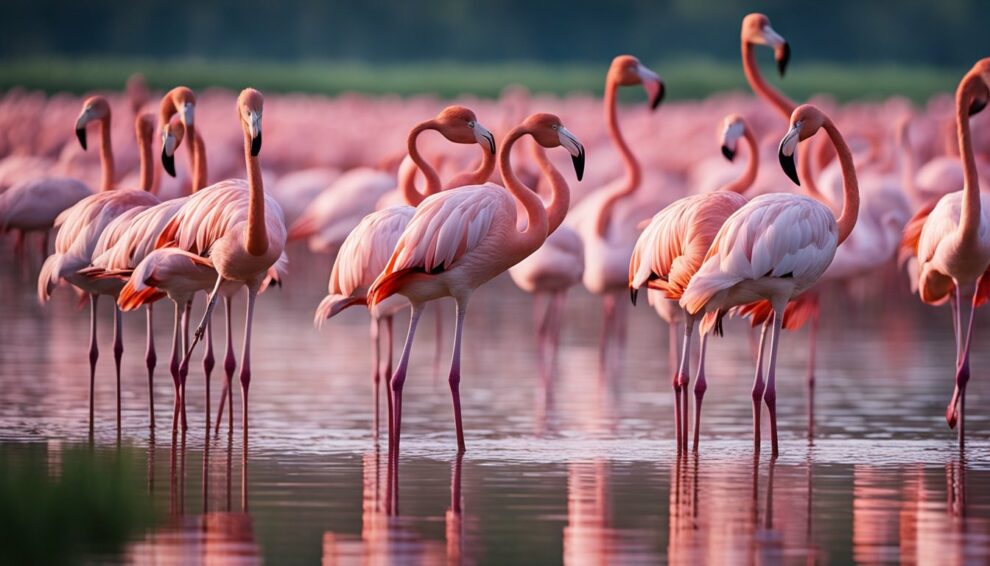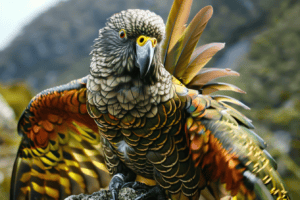Flamingos are not just famous for their striking pink plumage, but also for their dance.
But why do these birds dance, and what could these synchronized moves mean?
It turns out, flamingos have quite a bit in common with a well-rehearsed ballet troupe.
The dance moves they perform are not just for show; they serve an important purpose in the flamingo world.
When we watch these graceful birds, we witness a complex language of twists, turns, and stretches that is critical to their social structure.

Imagine an art performance where each participant is in perfect harmony with the next – that’s a flamingo dance.
Their dance is a mix of both individual artistry and collective choreography.
Flamingos perform a variety of dance moves such as head flagging, where they rhythmically move their heads from side to side.
This elaborate dance is a key part of their courtship ritual, essential for flamingos to find a mate.
It’s fascinating how their performances are meticulously timed and themed.
The dance becomes more intricate as a flamingo grows older and peaks at around 20 years of age.
This is when they demonstrate the most complicated and enthralling of moves.
Now, why should this matter to us? Well, these dances give us a glimpse into the elaborate social lives of flamingos.
They remind us that nature has its own forms of communication and expression.
Could watching and understanding flamingo dances help us appreciate the elaborate symphony of nature?
As the flamingos align in synchronization, perhaps they encourage us to tune into the rhythm of the natural world around us.
The dance of the flamingos is a splendid performance that unfolds in the wild, revealing the beautiful intricacies of animal behavior.
The Magic of Flamingo Dance
The synchronized ballet of flamingo dances is more than just an aesthetic delight; it’s a complex interplay of innate behavior and social cues vital for their survival.
These vibrant birds engage in such elaborate group displays to ensure the continuation of their species with each new breeding season.
Innate Rhythms and Group Coordination
Imagine watching an orchestra where each musician knows their part by heart. That’s akin to witnessing a flock of flamingos moving in harmony.
The innate sense of rhythm within these birds is astonishing.
With precision, they execute a series of coordinated dances, including head flagging and wing saluting.
It’s as if the flock shares one mind, yet scientists note that this unity is critical for maintaining group cohesion – a key to their survival out in nature.
The Art of Attraction
Picture the scene: rows of flamingos strutting their stuff, each one performing more elaborate dance moves than the last. Why all this fuss?
They’re trying to catch the eye of a potential mate.
Each courtship display, replete with synchronized preening and flamboyant strutting, is part of an intricate ritual to attract a partner.
This dance is both an art and a science, honing moves to perfection over years, reaching peak complexity around the age of 20.
Diet and Display: The Color Connection
Do you know what makes flamingos so vibrantly pink?
It’s all about their diet.
These birds feast on a carotenoid-enriched diet, full of shrimp and algae, which directly influences the hue of their plumage.
The pinker the plumage, the more attractive they are to potential mates.
So when they fan out their feathers in a grand display during their dances, they’re showcasing their health and desirability, thanks to those nutritious snacks they find in nature.
Flamingo Society and Social Gatherings

Flamingos are not just a burst of pink on the wetlands; they are creatures of intriguing social complexity.
Their social structures and behaviors are as brilliant as their plumage, especially when they come together in large, bustling groups known as “flamboyances.”
Forming the Flamboyance
Imagine a bustling city where everyone knows their place—this is what a flamingo flamboyance looks like.
Flamingos thrive in these large groups, sometimes consisting of thousands, where they can be seen engaged in a variety of synchronized activities.
This togetherness serves them well, offering safety in numbers and increased opportunities for foraging and mating.
The wetlands echo with the flurry of their wings as they settle in these dense flocks, creating a colorful tapestry against the backdrop of the water.
Breeding Rituals and Partner Selection
Breeding season is when flamingo society really kicks into high gear.
Have you ever seen a dance so meticulously performed it looks like an orchestrated ballet? This is the essence of the flamingo’s breeding ritual.
They commence with a coordinated marching display, heads held high, followed by a compelling series of synchronized movements involving head flagging and wing salutes.
These rituals are vital for partner selection, as they demonstrate health and vitality.
Once pairs are formed, they begin building nests from mud where they will raise their chick, feeding them with a nutritious substance called “crop milk.” It’s not milk as we know it, but a special secretion that is key to the growth of their young.
Their social rituals and intricate pair bonding are a window into the sophisticated world of flamingos, showcasing a society that is as complex as it is captivating.
Conservation and Human Influence

Flamingos aren’t born dancers; they perfect their steps over time.
Just like they rely on their flock to learn the moves, they depend on healthy environments to thrive.
Conservation efforts are essential to maintain their natural habitats, which are greatly affected by human activity.
Protecting the Wetlands
Flamingos need wetlands to survive, but these areas are under threat from human encroachment.
Initiatives to safeguard wetland areas are pivotal for flamingo conservation.
In Spain and Portugal, some nature reserves have become key sanctuaries where these birds can feed, mate, and raise their chicks.
For instance, the Spanish park “Doñana National Park” is a famous haven for flamingos.
Conserving these wet habitats not only supports flamingo populations but also benefits a wide array of other wildlife that call these wetlands home.
Cultural Impact and Awareness
The image of a flamingo often stirs curiosity and excitement, and this is where art and culture can play a role in conservation.
Spanish and Portuguese art have long been inspired by nature’s palette, and flamingos are a vibrant part of this tradition.
Museums and art shows that depict flamingos can raise awareness of their beauty and the importance of their preservation.
Sometimes, the dance of the flamingos is not just a performance in the wetlands but also a show in galleries and exhibits, teaching us the delicate steps of living in harmony with nature.
By engaging with cultural depictions of flamingos, people, especially young audiences, can become more connected to these birds and motivated to participate in their conservation.
Flamingos Across the Globe

In this section, we’ll uncover where different types of flamingos make their homes and how they’ve adapted to their varied ecosystems.
Varieties and Habitats
Flamingos are a dazzling spectacle with their pink hues and graceful poses, and they have made homes for themselves across many parts of the world.
Among the several species, the Greater Flamingo is a frequent sight in Southern France’s coastal wetlands, where they wade through the waters, creating a striking image against the azure sky.
They can also be found in parts of Africa, mingling with their smaller counterparts, the Lesser Flamingos.
On a different continent, in the nation of Chile, the Chilean Flamingos introduce a pop of color to the landscape.
Their presence in the muddy wetlands showcases nature’s artistry, where they employ their unique beaks to forage for food.
These birds are well recognized for their resilience, thriving in both the high altitudes of the Andes Mountains and the coastal regions where they become part of the scenery.
Adapting to Environments
One might wonder, how have these birds managed to become such global citizens?
Well, flamingos are masters of adaptation, overcoming challenges in the various environments they occupy.
In the fluctuating climates of Southern France, the Greater Flamingo makes itself comfortable with a diet rich in carotenoids, which aids in maintaining its feathered vibrancy.
Similarly, the Chilean Flamingos have evolved to navigate and forage within their space despite the changing conditions of their habitats.
The dramatic postures and transitions of their foraging techniques are not just a survival strategy; they are also a captivating dance that continues to draw the attention of onlookers and researchers alike.
Did you know that these splendid birds can change their foraging sites if one area becomes less habitable?
They can be quite resourceful, taking advantage of their surroundings to ensure they are always able to feed and survive.
This is just one example of how flamingos adjust their behavior to suit the wetlands, salt lakes, and lagoons they call home.
Frequently Asked Questions

Let’s satisfy your curiosity about flamingo dances with answers to some burning questions.
How do flamingos coordinate their dance movements?
Flamingos are social birds, and they rely on visual and auditory cues to sync up their dance moves.
When one flamingo starts a move, others follow, thanks to their keen attention to fellow flock members, creating a wave of harmonious movement.
What prompts flamingos to begin their synchronized dancing?
The start of their synchronized dancing is often a part of their breeding rituals.
The desire to attract a mate triggers these elaborate dance routines, whereby they showcase their health and vitality in hopes of finding the perfect partner.
In what ways do flamingos communicate during their dance?
During their complex dances, flamingos communicate using a combination of body movements and vocalizations.
Movements like head-flagging and wing-saluting help convey different messages and maintain synchronization among the group.
What role does dancing play in the life of a flamingo?
Dance is a crucial part of flamingo social structure.
It strengthens flock cohesion and is essential in their mating process, with their intricate moves acting as a barometer for selecting healthy and suitable mates.
How do flamingo’s dancing patterns vary during different seasons?
Flamingo dance patterns intensify during the breeding season when dances become more elaborate to attract mates.
Outside of this time, their movements are more relaxed and less synchronized, reflecting the absence of the need to impress.
What are the differences between the dances of flamingos and other birds?
Flamingo dances are distinct in their reliance on group coordination and complexity, especially compared to solitary courtship displays found in other bird species.
While some birds may dance alone or in pairs, flamingos uniquely perform their synchronized rituals in large groups, creating an eye-catching spectacle.









